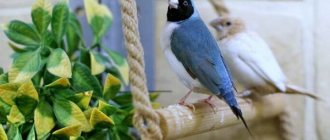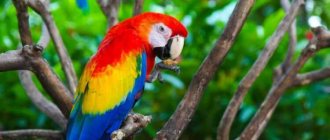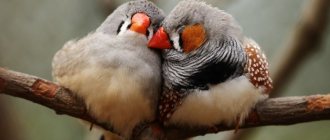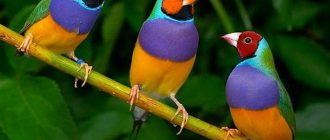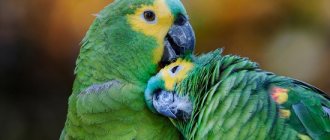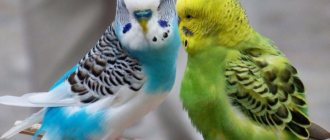Review author: “ZooVita”
Breeding ornamental birds is a fairly common practice today. And these birds are not always parrots of various subspecies. Amadin is an example of an incredibly beautiful and easy-to-care representative of the passerine family.
You can recognize a finch in a photo by its specific coloring and a number of other original characteristics.
Habitat and life expectancy
Birds of this family are common in almost all regions, but mainly in warm regions: Australia, Oceania, and the countries of both American continents.
The total lifespan of ornamental birds is about 5 years. The question of how long finches live is quite controversial. In practice, the quality of care, diet, and prevention of specific diseases are important.
Most of the subspecies prefer flat steppes, some individuals live in forests or on the edges.
Diet in natural conditions
In the wild, birds feed mainly on plant foods, preferring to feast on grain crops, seeds of plants and fruit trees. However, to replenish the required amount of protein, some individuals may consume larvae, caterpillars and small insects.
For domesticated birds, the diet is calculated based on their required energy needs, calorie content and activity of the pet.
Main varieties and their features
Ornithologists identify about 38 species of these birds, with each species divided into several subspecies. Among the most famous are:
- Japanese look.
- Chinese sparrows.
- Zebra finch.
Depending on the phenotypic characteristics, red-headed, chestnut-breasted and scaly-breasted birds, sharp-tailed and diamond species are also distinguished.
Description
| The species includes 38 species: | |
| Eastern Black-headed Munia Lonchura atricapilla Black-and-White Finch Lonchura bicolor Grey-headed Munia Lonchura caniceps Silver-billed Finch Lonchura cantans Chestnut-breasted Finch Lonchura castaneothorax Bronze-winged Finch Lonchura cucullata Javan Munia Lonchura ferruginosa Yellow Munia Lonchura flaviprymna Striped-breasted I munia Lonchura forbesi Large chemise finch Lonchura fringilloides Brown finch Lonchura fuscans Large Munia Lonchura grandis Pearl-headed finch Lonchura griseicapilla Grey-necked finch Lonchura hunsteini Golden-rumped finch Lonchura kelaarti White-bellied finch Lonchura leucogastra Java finch Lonchura leucogastroides Spotted finch Lonchura leucosticta White-headed finch Lonchura maja | Malabar finch Lonchura malabarica Black-headed munia Lonchura malacca Thick-billed finch Lonchura melaena Moluccan finch Lonchura molucca Highland munia Lonchura montana Junge Alpine munia Lonchura monticola Yellow-breasted munia Lonchura nevermanni Stresemann Mourning munia Lonchura nigerrima Brown-backed munia Lonchura nigriceps Pale-headed munia Lonchura pallida White-bellied munia Lonchura pallidiventer Restall Scaly-breasted finch Lonchura punctulata Five-colored munia Lonchura quinticolor Magnificent munia Lonchura spectabilis Sharp-tailed bronze finch Lonchura striata Black-breasted munia Lonchura stygia Stresemann Black-breasted munia Lonchura teerinki Rand Mourning finch Lonchura tristissima White-faced munia Lonchura vana |
Chinese sparrows
Representatives of this group are distinguished by their chocolate colored back, head and tail. The abdominal plumage is white.
The character is calm, unpretentious in care. Birds are very talkative, constantly making a lot of loud sounds, and sometimes you can hear singing.
Caring for chicks
After mating games, the female sits in the nest and lays 2–5 white eggs. She warms the clutch during the day alternately with the male; at night the finches sit together on the eggs. After 12 - 16 days, the chicks appear, naked, blind and helpless. The parents feed them partially digested food, which is regurgitated from the crop into the beaks of the young. On the third day, the chicks begin to develop fluff, the first sounds appear - a voice emerges.
The features of caring for finches chicks do not differ from those required for any birds. The young begin to fly after three weeks and try to fly out of the nest. At this time, the brood must be diligently monitored and returned to its parents after a fall. It is recommended to secure several thin perches near the nest, on which the chicks will learn to jump and take off. It is possible that by the time the young birds are placed in another cage, the female will begin nesting again.
Exotic birds, finches, are capable of delighting people with just their appearance. And if they start singing and taking food from their hands, no one remains indifferent. You shouldn’t expect the same emotional response from these birds as from parrots, but the serene twitter of finches creates a very cozy atmosphere in the house.
Species with scaly breast
Another representative of the passerine order, whose color really resembles small scales. The brown (even chocolate) back, head, neck, tail in an original way emphasize the pockmarked coloring of the chest. These birds build spherical nests, choosing the tallest trees for this purpose.
Many subspecies received their names precisely because of the peculiarities of their appearance (chestnut coloring of the plumage on the chest, a bright red stripe under the neck, a sharp long tail of an ash color).
Interesting Facts
- Scientists have found that the brain function of finches during sleep begins to activate after they listen to the songs of their parents. The degree of brain activity depends on how many songs the chick heard per day.
- Finches belong to the order of passeriformes not for their external resemblance to gray birds, but for their ability to make round nests by twisting blades of grass.
- Despite the fact that finches are commonly called songbirds, they cannot boast of their vocal abilities. Their singing resembles croaking, whistling, hissing. Females sing much worse than males and often scare off enemies in nature.
- Finches are birds that often mate with representatives of birds from other similar families. Because of this, they are carriers of a wide variety of colors.
- Finches inherited one of their character traits from cuckoos: they often leave their chicks to the will of fate when they are in a long search for food.
- Finches will always lead a tourist lost in the Australian forests to the water, since these birds always stay near water sources.
- Males perform a courtship dance in front of the female while sitting on a tree branch. As a gift before mating, the female receives a twig or feather from the beak of her chosen one.
- The color of finches depends on their habitat. Zebras get their name from the white and black stripes on their tails. Japanese are very rarely found in nature, as they are artificially bred. Only Gould's finches, which can combine all the colors of the rainbow, can compete with the Japanese in beauty. Rice birds are the largest birds with a white-gray monochromatic color.
Keeping at home
Today, keeping ornamental domesticated birds is becoming very popular. How to properly prepare for keeping a finch at home:
- First of all, you will need a cage of sufficient size. As a rule, for comfortable living and growth, a bird needs a cage measuring 30*20*25 cm.
- A retractable tray is definitely needed, the presence of which will greatly facilitate cleaning and caring for the birds.
- It is better to clean it several times a week or when it gets dirty. Lack of proper care will inevitably lead to a persistent odor and even illness in your pet.
It is better to install the cage in the sunniest room with sufficient temperature, because you should remember that members of the family love warmth.
Finches at home need to provide adequate natural lighting, constant temperature control and adherence to a rational diet. This approach ensures growth, development and high-quality disease prevention for birds.
Reviews
Dmitry Evgenievich, 46 years old, Tula
I thought for a long time about whether it was worth having a pet in the apartment. We definitely decided not to consider cats and dogs, opting for birds. My daughters have wanted a parrot or a canary for a long time, but they and I decided that we should be original and consider getting a bird that others don't have. Olesya and Anya went to the pet store on their own and literally fell in love at first sight with bright birds called finches. It was New Year's Eve.
These creatures cost much less than a parrot, and I promised that I would compensate my daughters for this difference with other gifts, but we still did not know what tests we would have to go through! Firstly, instead of the gentle singing of birds, we got constant sounds reminiscent of... the croaking of frogs! My wife, for example, really liked these sounds, but we just went crazy. Secondly, finches are so unclean that they had to clean the cage almost every day. We still didn’t understand what use the finches were – neither to play, nor to talk – just to listen to the constant strange sounds they made. Two little “parasites” did not live with us for long. My daughters immediately said that they wouldn’t cope, so we went to the pet store again, but not for a new purchase, but to hand them over.
Karina Sergeevna, 37 years old, Krasnoyarsk
The character of adult finches can also be recognized by the behavior of their newborn chicks. The birds themselves are charming: round shiny eyes, contrasting with a very serious face; red nose, bright plumage. Not to say that they are more beautiful than parrots, but much more original than other birds. I bought two for my office at once: a male and a female. I have quite a few clients, and I decided that I would have fun with them. My pair of finches turned out to be quite prolific: there were chicks, and more than once. The first chicks turned out to be so noisy and demanding of food that it seemed to me that they needed to be moved away, otherwise the parents would die from fatigue! I won’t say what happened to these little birds (some died, some had to be given to friends), but a couple still lives with me.
Dinara Sharapova, 23 years old, Bashkortostan
I always wanted to have a pet that would become my friend. As a child, I already had a parrot, which died very quickly, and it took me a long time to recover from this shock. I decided to buy a bird with the beautiful name Amadin. Chicha was on the same wavelength as my child: she demanded constant attention, but did not give anything in return. If you didn’t feed her once, Chichi’s squeak would be heard in the apartment within a radius of ten meters. After this incident, my bird did not live a day without such hysterics. “I taught women to speak, but, God, how can I silence them!” - I remembered the lines of a famous poem, and I resigned myself, because Chicha does not understand me, and attempts to re-educate her end in nothing. After all, we are responsible for those we have taught, so I continue to keep Chicha with me. Conclusion: the finch will not become your friend, it is unlikely to entertain you, but it will develop tolerance in you.
